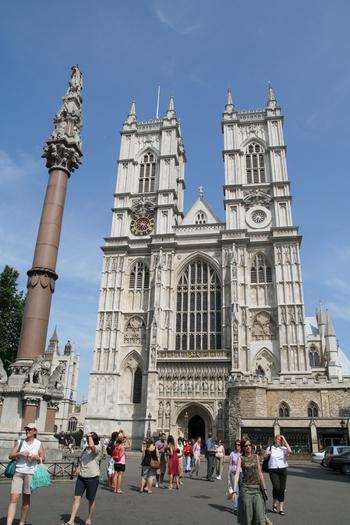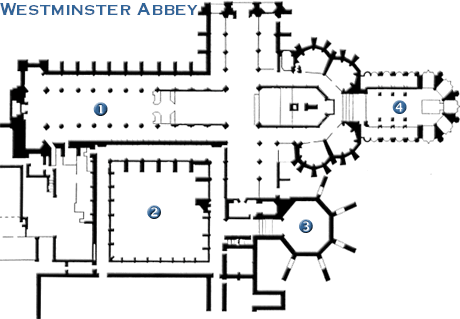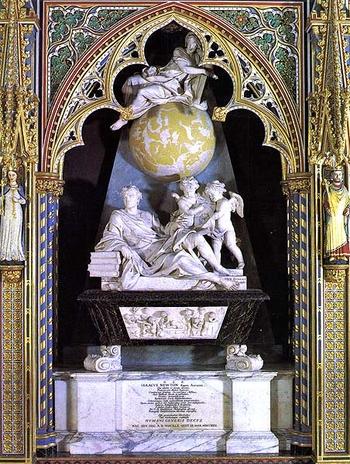Westminster Abbey
Introduction
 Westminster Abbey, located near the Houses of Parliament, is more a historical site than a religious site. The Collegiate Church of St Peter at Westminster, popularly known as Westminster Abbey, is a large, mainly Gothic church, in the City of Westminster, London, United Kingdom. It is the traditional place of coronation and burial site for English, later British and later still (and currently) monarchs of the Commonwealth realms. The abbey is a Royal Peculiar and briefly held the status of a cathedral from 1540 to 1550.
Westminster Abbey, located near the Houses of Parliament, is more a historical site than a religious site. The Collegiate Church of St Peter at Westminster, popularly known as Westminster Abbey, is a large, mainly Gothic church, in the City of Westminster, London, United Kingdom. It is the traditional place of coronation and burial site for English, later British and later still (and currently) monarchs of the Commonwealth realms. The abbey is a Royal Peculiar and briefly held the status of a cathedral from 1540 to 1550.- Westminster Abbey is a collegiate church governed by the Dean and Chapter of Westminster, as established by Royal charter of Queen Elizabeth I in 1560, which created it as the Collegiate Church of St Peter Westminster and a Royal Peculiar under the personal jurisdiction of the Sovereign. The members of the Chapter are the Dean and four residentiary Canons, assisted by the Receiver General and Chapter Clerk. One of the Canons is also Rector of St Margaret's Church, Westminster, and often holds also the post of Chaplain to the Speaker of the House of Commons. In addition to the Dean and Canons, there are at present two full-time minor canons, one praecentor, the other succentor. The office of Priest Vicar was created in the 1970s for those who assist the minor canons. Together with the Clergy and Receiver General and Chapter Clerk, various Lay Officers constitute the College, including the Organist and Master of the Choristers, the Registrar, the Auditor, the Legal Secretary, the Surveyor of the Fabric, the Head Master of the Choir School, the Keeper of the Munimentums and the Clerk of the Works, as well as twelve Lay Vicars and ten of the choristers and the High Steward and High Bailiff. There are also forty Queen's Scholars who are pupils at Westminster School (the School has its own Governing Body). Those who are most directly concerned with liturgical and ceremonial matters are the two Minor Canons and the Organist and Master of the Choristers.
The interior is a veritable museum of English history. Among many highlights are the medieval coronation throne; Poet's Corner with its memorials to William Shakespeare, Charles Dickens, and other giants of literature; and the tombs of Queen Elizabeth I, «Bloody» Queen Mary, explorer David Livingstone and naturalist Charles Darwin.
History
According to tradition, a shrine was first founded here in 616 on a site then known as Thorney Island. It was said to have been miraculously consecrated after a fisherman on the River Thames saw a vision of Saint Peter.
- While the existence of this shrine is uncertain, the historic Abbey was built by Edward the Confessor between1045-1050 and was consecrated on December 28, 1065. Its construction originated in Edward's failure to keep a vow to go on a pilgrimage; the Pope suggested that he redeem himself by building an Abbey.
- The original Abbey, in the Romanesque style that is called «Norman» in England, was built to house Benedictine monks. It was rebuilt in the Gothic style between1245-1517. The first phase of the rebuilding was organized by Henry III, in Gothic style, as a shrine to honor Edward the Confessor and as a suitably regal setting for Henry's own tomb, under the highest Gothic nave in England.
The work was largely finished by the architect Henry Yevele in the reign of King Richard II. Henry VII added a Perpendicular style chapel dedicated to the Virgin Mary in 1503 (known as the Henry VII Lady Chapel).
Although the Abbey was seized by Henry VIII during the Dissolution of the Monasteries in 1534, and closed in 1540, becoming a cathedral until 1550, its royal connections saved it from the destruction wrought on most other English abbeys. The expression «robbing Peter to pay Paul» may arise from this period when money meant for the Abbey, which was dedicated to St. Peter, was diverted to the treasury of St. Paul's Cathedral.
It suffered damage during the turbulent 1640s, when it was attacked by Puritan iconoclasts, but was again protected by its close ties to the state during the Commonwealth period. Oliver Cromwell was given an elaborate funeral there in 1658, only to be disinterred in January 1661 and posthumously hanged from a nearby gibbet.
The Abbey was restored to the Benedictines under Queen Mary, but they were again ejected under Queen Elizabeth I in 1559. In 1579, Elizabeth re-established Westminster as a «royal peculiar» – a church responsible directly to the sovereign, rather than to a diocesan bishop – and made it the Collegiate Church of St. Peter, (i.e. a church with an attached chapter of canons, headed by a dean).
The abbey's two western towers were built between 1722 and 1745 by Sir Christopher Wren and Nicholas Hawksmoor, constructed from Portland stone to an early example of a Gothic Revival design. Further rebuilding and restoration occurred in the 19th century under Sir George Gilbert Scott.
- Until the 19th century, Westminster was the third seat of learning in England, after Oxford and Cambridge. It was here that the first third of the King James Bible Old Testament and the last half of the New Testament were translated. The New English Bible was also put together here in the 20th century.
Coronations in Westminster Abbey
- The coronation of the new Sovereign follows some months after his or her accession, following a period of mourning and as a result of the enormous amount of preparation required to organise the ceremony. The coronation ceremony has remained essentially the same over a thousand years. For the last 900 years, the ceremony has taken place at Westminster Abbey, London. Since the Christmas Day coronation of William the Conqueror in 1066, all English monarchs (except Lady Jane Grey, Edward V and Edward VIII, who did not have coronations) have been crowned in the Abbey. The Archbishop of Canterbury is the traditional cleric in the coronation ceremony. St. Edward's Chair, the throne on which British sovereigns are seated at the moment of coronation, is housed within the Abbey.
Henry III was unable to be crowned in London when he first came to the throne because the French prince Louis had taken control of the city, and so the king was crowned in Gloucester Cathedral. However, this coronation was deemed by the Pope to be improper, and a further coronation was held in the Abbey on 17 May 1220. The Archbishop of Canterbury is the traditional cleric in the coronation ceremony.
King Edward's Chair (or St Edward's Chair), the throne on which English and British sovereigns have been seated at the moment of coronation, is housed within the Abbey and has been used at every coronation since 1308. From 1301 to 1996 (except for a short time in 1950 when it was temporarily stolen by Scottish nationalists), the chair also housed the Stone of Scone upon which the kings of Scots are crowned. Although the Stone is now kept in Scotland, in Edinburgh Castle, at future coronations it is intended that the Stone will be returned briefly to St Edward's Chair for the moment of coronation.
Royal weddings in Westminster Abbey
Since 1100, there have been at least 16 royal weddings at Westminster Abbey. Only two were weddings of reigning monarchs (Henry I and Richard II), and there were none at all for more than five centuries between 1382 and 1919.
Chronology
- 4 January 1243: Richard, Earl of Cornwall (later King of Germany), brother of King Henry III of England, to Sanchia of Provence (his second wife). Sanchia was sister of Eleanor of Provence, Henry III’s queen.
- 9 April 1269: Edmund of Crouchback, 1st Earl of Leicester and Lancaster, son of King Henry III was married to Lady Aveline de Forz
- 30 April 1290: Joan of Acre, daughter of King Edward I was married to the 7th Earl of Gloucester
- 8 July 1290: Margaret of England, daughter of King Edward I was married to John II, son of Duke of Brabant
- 20 January 1382: King Richard II of England was married to Anne of Bohemia
- 27 February 1919: Princess Patricia of Connaught was married to Capt the Hon Alexander Ramsay
- 28 February 1922: The Princess Mary, daughter of King George V was married to Viscount Lascelles
- 26 April 1923: The Prince Albert, Duke of York (later King George VI), second son of King George V was married to Lady Elizabeth Bowes-Lyon (later to become Queen Elizabeth the Queen Mother)
- 29 November 1934: The Prince George, Duke of Kent, son of King George V was married to Princess Marina of Greece and Denmark
- 20 November 1947: The Princess Elizabeth (now Queen Elizabeth II), elder daughter of King George VI was married to The Duke of Edinburgh (who was Lt Philip Mountbatten until that morning)
- 6 May 1960: The Princess Margaret, second daughter of King George VI was married to Antony Armstrong-Jones (later Earl of Snowdon)
- 24 April 1963: Princess Alexandra of Kent was married to the Hon Angus Ogilvy
- 14 November 1973: The Princess Anne, only daughter of Elizabeth II was married to Captain Mark Phillips
- 23 July 1986: The Prince Andrew, Duke of York, second son of Elizabeth II, was married to Miss Sarah Ferguson
- 29 April 2011: Prince William, Duke of Cambridge, grandson of Elizabeth II was married to Miss Catherine Middleton (royal wedding official portrait)
The inside of Westminster Abbey
The Nave
The abbey's nave (1) is England's highest. In the nave you find the Grave of the Unknown Warrior, a World War I soldier who died on the battlefields in France and was buried here in French soil. Nearby is a marble memorial stone for Winston Churchill. His body is not, like many fellow prime ministers, buried in the abbey, but in Bladon.
The Cloister
The Cloister (2) was originally built in the 13th century. It was completely rebuilt after it was destroyed by a fire in 1298. The cloister was used by the Benedictine monks for meditation and exercise.
Chapter House
The beautiful octagonal Chapter house (3) is one of the largest of its kind in England. It has an original tile floor dating from 1250 and 14th century murals.
Henry VII Chapel
The Henry VII Chapel (4), built 1503-1512, is one of the most outstanding chapels of its time, with a magnificent vault. The chapel has a large stained glass window, the Battle of Britain memorial window. The window, which dates from 1947 and replaces an original window that was damaged during World War II, commemorates fighter pilots and crew who died during the Battle of Britain in 1940.

 Henry III rebuilt the Abbey in honour of the Royal Saint Edward the Confessor, whose shrine and relics were placed in the Sanctuary. The Shrine of St. Edward the Confessor (in the picture) has been the focus of pilgrimages to Westminster Abbey since the Middle Ages.
Henry III rebuilt the Abbey in honour of the Royal Saint Edward the Confessor, whose shrine and relics were placed in the Sanctuary. The Shrine of St. Edward the Confessor (in the picture) has been the focus of pilgrimages to Westminster Abbey since the Middle Ages.
Henry III was buried nearby as were the Plantagenet kings of England, their wives and relatives. Subsequently, most English kings and queens were buried here. However, Henry VIII and Charles I are buried at St. George's Chapel in Windsor Castle, as all royals have been since George II.
- Aristocrats were buried inside chapels of Westminster Abbey and monks and people associated with the Abbey were buried in the cloisters and other areas. One of these was Geoffrey Chaucer, who was buried here as he had apartments in the Abbey as he was employed as master of the Kings Works.
Other poets were buried around Chaucer in what became known as Poets' Corner. Abbey musicians such as Henry Purcell were also buried in their place of work. Subsequently it became a great honor to be buried or memorialized here. The practice spread from aristocrats and poets to generals, admirals, politicians, scientists, doctors, and others.
Burials in Westminster Abbey
Burials in the North Transept
Burials in the North Choir Aisle
|
Burials in the South Transept (Poets' Corner)
|
